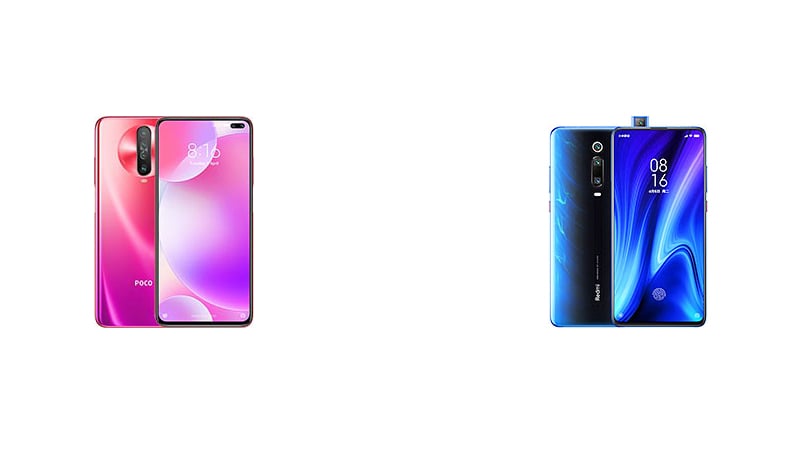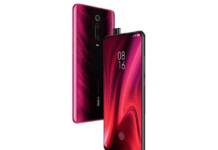Xiaomi’s sub-brand which recently became independent from the company just announced the Poco X2 in India: its second smartphone alias the successor of the famous affordable flagship known as Pocophone F1 in the global market. The new model is essentially a rebranded version of the Redmi K30 with no difference. And we think it is worth comparing it with its predecessor which is currently sold in the Indian market at a similar price: Redmi K20. Unlike what you might think, this comparison is all but obvious. Although the Poco X2 is the successor of the Redmi K20, it does not necessarily mean it is a better deal for everyone.
Thanks to this specs comparison, you will understand why.

Xiaomi Poco X2 vs Xiaomi Redmi K20
| Xiaomi Poco X2 | Xiaomi Redmi K20 | |
|---|---|---|
| DIMENSIONS AND WEIGHT | 165.3 x 76.6 x 8.8 mm,
208 grams |
156.7 x 74.3 x 8.8 mm,
191 grams |
| DISPLAY | 6.67 inches, 1080 x 2400p (Full HD+), 386 ppi, IPS LCD | 6.39 inches, 1080 x 2340p (Full HD+), 403 ppi, Super AMOLED |
| PROCESSOR | Qualcomm Snapdragon 730G, octa-core 2.2 GHz | Qualcomm Snapdragon 730, octa-core 2.2 GHz |
| MEMORY | 6 GB RAM, 64 GB – 6 GB RAM, 128 GB – 8 GB RAM, 256 GB – micro SD slot | 6 GB RAM, 64 GB – 6 GB RAM, 128 GB – 8 GB RAM, 256 GB |
| SOFTWARE | Android 10, MIUI | Android 9 Pie, MIUI |
| CONNECTIVITY | Wi-Fi 802.11 a/b/g/n/ac, Bluetooth 5.0, GPS | Wi-Fi 802.11 a/b/g/n/ac, Bluetooth 5.0, GPS |
| CAMERA | Quad 64 + 8 + 2 + 2 MP f/1.9, f/2.2, f/2.4 and f/2.4
Dual 20 + 2 MP f/2.4 and f/2.2 front camera |
Triple 48 + 8 + 13 MP f/1.8, f/2.4 and f/2.4
20 MP f/2.2 front camera |
| BATTERY | 4500 mAh Fast charging 27W |
4000 mAh, Fast charging 18W |
| ADDITIONAL FEATURES | Hybrid Dual SIM slot, splash resistant | Dual SIM slot |
Design
Despite being a 2019 mid-ranger, the design of the Redmi K20 still looks amazing. Unlike the Poco X2 that comes with a dual punch-hole display, the Redmi K20 has a holeless display, no notch, and no punch-hole, thanks to a motorized pop-up camera. That is why I personally prefer its aesthetics over the Poco X2.
The presence of a pop-up camera hasn’t increased its thickness. The Redmi K20 has exactly the same thickness as the Poco X2 and it even weighs less. On both devices, you get a glass back protected by Gorilla Glass 5 and an aluminum frame. But only the Poco X2 is splash resistant, while Redmi K20 does not offer any kind of protection against water.
Display
The display of the Poco X2 is very innovative thanks to its high 120 Hz refresh rate, but it is an IPS panel and some might not prefer it over AMOLED. On the other hand, Redmi K20 lacks a high refresh rate, but it offers an AMOLED display (with HDR support just like the Poco X2) as well as an under-display fingerprint scanner (on the Poco X2, there is a side-mounted fingerprint reader).
The 120Hz refresh rate is definitely a big leap over the 60Hz AMOLED screen on the K20. But end of the day, it’s going to be a personal choice. You have to choose between a high-refresh-rate LCD screen over a regular refresh rate AMOLED display with better colors.
Both displays are protected by Gorilla Glass 5, but Poco X2 has dual punch-hole cameras, while Redmi K20 is notch-less and holeless thanks to a pop-up camera.
Specs & Software
Poco X2 and Redmi K20 are powered by the Snapdragon 730G and the Snapdragon 730 chipsets, respectively. The Snapdragon 730G offers higher graphics performance than Snapdragon 730, while for the rest they are essentially the same chipset. So if you are a gamer and you care about GPU, Poco X2 is way better. Further, Poco X2 features expandable storage, while Redmi K20 does not have a memory card slot. Last but not the least, Poco X2 has Android 10 out of the box, while Redmi K20 ships with Android 9 Pie since it was released in June 2019.
Camera
Poco X2 offers more cameras on the rear side, but Redmi K20 has a more interesting setup, thanks to the presence of a telephoto sensor. The telephoto lens is way harder to find on a mid-range smartphone compared to the kind of sensors found on the Poco X2. But the Poco X2 wins when it comes to front cameras, thanks to a dual 20 + 2 MP setup including a depth sensor.
Anyways, both are midrange camera phones, so do not expect anything special from them. However, lately, mid-range smartphone cameras are capable enough to give you excellent captures, comparable to more expensive devices. So both the devices will offer good quality samples, especially in bright daylight.
Battery
Poco X2 has a bigger 4500 mAh battery and it should last a lot more on a single charge, despite featuring a less efficient display. Further, it has a faster-charging technology with 27W power, while Redmi K20 features a 4000 mAh battery with 18W fast charging.
So, on the battery side, X2 wins the comparison.
Price
Despite being the successor of the Redmi K20, The Pocophone X2 starts from a more affordable price tag than Redmi K20 in India. The handset just debuted in the Indian market with a starting price tag of just Rs. 15,999 for the base variant (6/64 GB), which roughly translates into about $225 at the current exchange change. The intermediate configuration with 6 GB of RAM and 128 GB of internal storage costs Rs. 16,999 which roughly translates into $239, while the most powerful version with 8 GB of RAM and 256 GB native storage costs Rs. 19,999 that is equivalent to about $281.
For Rs. 19,999, you can currently get just the base variant of the Redmi K20 which offers 6 GB of RAM and 64 GB of internal storage (and we are talking about the street price). I would personally prefer the Poco X2 aka Redmi K30 not only for its higher value for money but also because of its splash-resistant design, high refresh rate, better chipset, wider display, micro SD support and a bigger battery with faster charging.
Note that the Redmi K20 actually offers a more interesting AMOLED panel and cameras, as well as an in-display fingerprint reader, so you should not underestimate it. In both cases, you get an amazing mid-ranger.
What would be your choice with the current pricing?
Xiaomi Poco X2 vs Xiaomi Redmi K20: PRO and CONS
Xiaomi Poco X2
PRO
- 120 Hz
- Android 10 out of the box
- Micro SD slot
- Bigger battery
CONS
- LCD display and no UD fingerprint scanner
Xiaomi Redmi K20
PRO
- AMOLED display and UD fingerprint reader
- Holeless design
- Telephoto lens
- More compact
CONS
- Smaller battery






